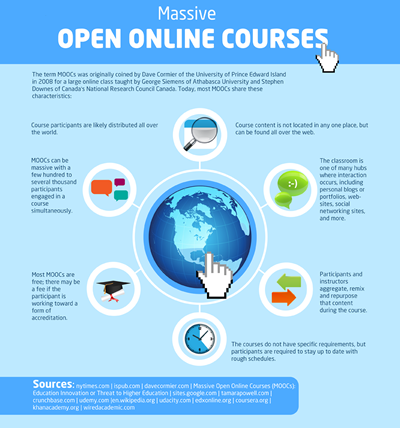Lesson 25: Education
Attention
Click on the image to see a larger version of this.
This is a graphic that represents a new trend in education...the MOOC
Learning Outcomes
Upon completion of this lesson's material, students will be able to:
- Describe the Sociological Perspectives of Education
- Describe existing problems in education and possible solutions
Teaching
Perspectives on Education
Your textbook does a good job examining the different perspectives related to eduction. However, I place the "Feminist" perspective into the overall "Conflict" perspective.
Review the following perspectives covered in your text:
- Functional perspective on education
- Conflict perspective on education
- Symbolic interactionist perspective
Functions of Education
Manifest Functions (primary and overt functions of education)
- Socializing agents
- Transmit knowledge and culture
- Cultural integration
- Innovation
- Benefit to the economy
Latent Functions
- Provide child care
- Matchmaking
- Decrease job competition for CURRENT jobs
- Create social networks
- Good for (support) businesses
Post Modern Perspective
- Education as a business/product
- Students as "Customers"
- "Profit" or "Non-Profit" Institutions
- Charter Schools
- MOOC (Massive Open Online Courses)
Experience a MOOC
I would like you to check out a sample MOOC course through a website called Coursera. When you visic Coursera click on the "View All Courses" link. Then search for the ones in "English" (if your preferred language is English!).
Pick any class that you find interesting and, in the least, watch the entire "Intro Video"...all these classes are free so you are able to take them if you wish.
Problems in Education
- Is education equitable?
- IQ, GPA, and SAT scores
- Hidden Curriculum and Social Control
- Credentialism
- Gender
- Relevance
Education is a cultural universal, but the values, norms, and expectations of education in different cultures varies dramtically. To see how we are different in these ways I want you to visith the "Learning Curve" website. This website looks at Education statistics (along with other statistics related to culture) around the globe.
There are different tools available on this site to view the interaction between culture and education. In our discussion, we will be looking at cultural indicators and education in the Country Profiles section.
We can compare countries based on these indicators and speculate as to how cultural differences might influence the structure and outcomes of education in that country. We can first gather statistics and then look up the education systems in each country we pick. Here is an example:
Canada
- Sample Education Facts
- 12.3% of government expenditures are put into education
- Graduation rates are 85.10% (high school) and 35.24% (college)
- Pupil/teacher ratio is 17.42 pupils per student
- Other Data
- Human Development index is .91 (a composit statistic of life expectancy, education, and income)
- Unemployment is 7.29%
Finland
- Sample Education Facts
- 12.26% of government expenditures are put into education
- Graduation rates are 96.03% (high school) and 46.60% (college)
- Pupil/teacher ratio is 13.67 pupils per student
- Other Data
- Human Development index is .89
- Unemployment is 7.75%
Analysis
The real differences between Canada and Finland are in terms of graduation rates and pupil teacher ratio. A lower ratio of teachers to students may be a part of the higher graduation rate. Similar expenses from government are reported for both countries. Visiting the Wiki sites on each country reveals significant differences between the country's basic expectations.
Assessment
Possible Class Discussion
Reflect on your experience exploring a MOOC. Consider a world where we no longer offered degrees but instead people built up the skills they needed (and documented them) through MOOC type experiences. Would you trust a doctor trained this way? Reflect on other professions as well.
